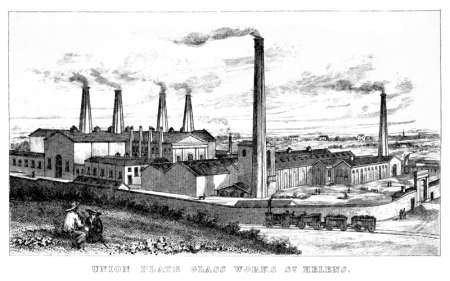Works for the Union Plate Glass Company, Pocket Nook, St Helens
The Union Plate Glass Company was formed in 1837 with David Bellhouse, junior, Richard Lane, Henry Charles Lacy, mail contractor, and Samuel Nicholls, merchant, as directors. The capital raised for carrying on this extensive undertaking being £180,000, in 600 shares of £30 each. The foundation-stone of the intended works of this company at Pocket Noook,St Helen's, was laid on Wednesday the 21 June 1937 by H. C. Lacy, of Manchester. Afterwards a party of about seventy gentlemen dined together at the at Raven Inn, St. Helens in celebration of the event, Mr, Lacy in the chair, and Mr. Richard Lane, architect of the works, and Mr. David Bellhouse, the contractor for the erection of them, in the vice-chairs. By that stage a great number of men were employed, and so rapidly had operations been carried on that £20,000 had already been expended towards finishing the building. It was anticipated that before Christmas of that year the company would commence the manufacture of glass, sections of the works suitable for the purpose being intended to be completed before that time.
The site exceeded eight statute acres, bounded on the easterly side by the Sankey canal, and on the south westerly, by a branch line from the Liverpool and Manchester railway, seeming thereby the utmost possible economy and facility of communication with all parts of the United Kingdom. Within fifty yards of the northerly end of the works were coal pits, which could furnish ample supplies of the best fuel at the lowest possible rates. The main building, or casting hall, was near 260 feet long by 156 feet wide, and comprised two founding and two refining furnaces, four pot arches, twenty annealing kilns. The casting table was 17 feet by 9 feet, and 6 inches thick, and, with the roller and frame on which it moves, was upwards of 20 tons. There are four founding pots used at one time in the foundry furnace, each pot containing generally one ton of gauged fluxed metal. Pots holding one ton and a quarter each have been used, but a ton is the general size. The present establishment, with one founding and one refining furnace at work, yields weekly from 5,000 to 6,000 feet superficial measure of plate glass. The machinery department embraces a lifting engine of eight-horse power, to supply water of a superior quality; the condensing water and water for general purposes being procured from the canal. An engine made by Boulton and Watt controls the polishing and grinding machines, as well as the clay, emery, and plaster mills, with a power equivalent to 200 horses. ‘ The other buildings subservient to general purposes embrace salt-house, for preparing the alkali; sand-washing rooms; store and mixing rooms; pot, clay, and brick rooms; gashouse, etc.; ochre and plaster ovens; smithy; joiner’s shop; warehouse, and silvering room ; all of which are so arranged as to be the most advantageous and economical in the application of manual labour. There were upwards of 600 hands employed, about one-third being females, the latter being principally engaged in the process of polishing mirror glass. The quantity of glass annually made at the works was very large; and while the home market was extensively supplied, the company also met export demands from various parts of the globe
At Pocket Nook Works a library existed, and other means were provided by the directors for the improvement of the social and intellectual welfare of the workpeople. Due to the rise in cost of fuel and competition from other sources, the company closed its Pocket Nook, St Helens works for 9-12 months in 1892 to allow structural alterations[Liverpool Mercury, 7 March, 1892]. Production ceased in 1898.
Reference Manchester Guardian 13 May 1837 page 1
Reference Manchester Times 1 July 1837 page 2
Reference Civil Engineer June 1839 page 233
Reference The Mirror of Literature Amusement and Instruction 11 March 1843 page 145-146
Reference The Mirror of Literature Amusement and Instruction 25 March 1843 page 178
Reference Manchester Courier 14 July 1855 page 7 - visit
Illustration The Mirror of Literature Amusement and Instruction 11 March 1843 page 145
Illustration Bradshaw's Hand-Book to the Manufacturing Districts of Great Britain, page 141
